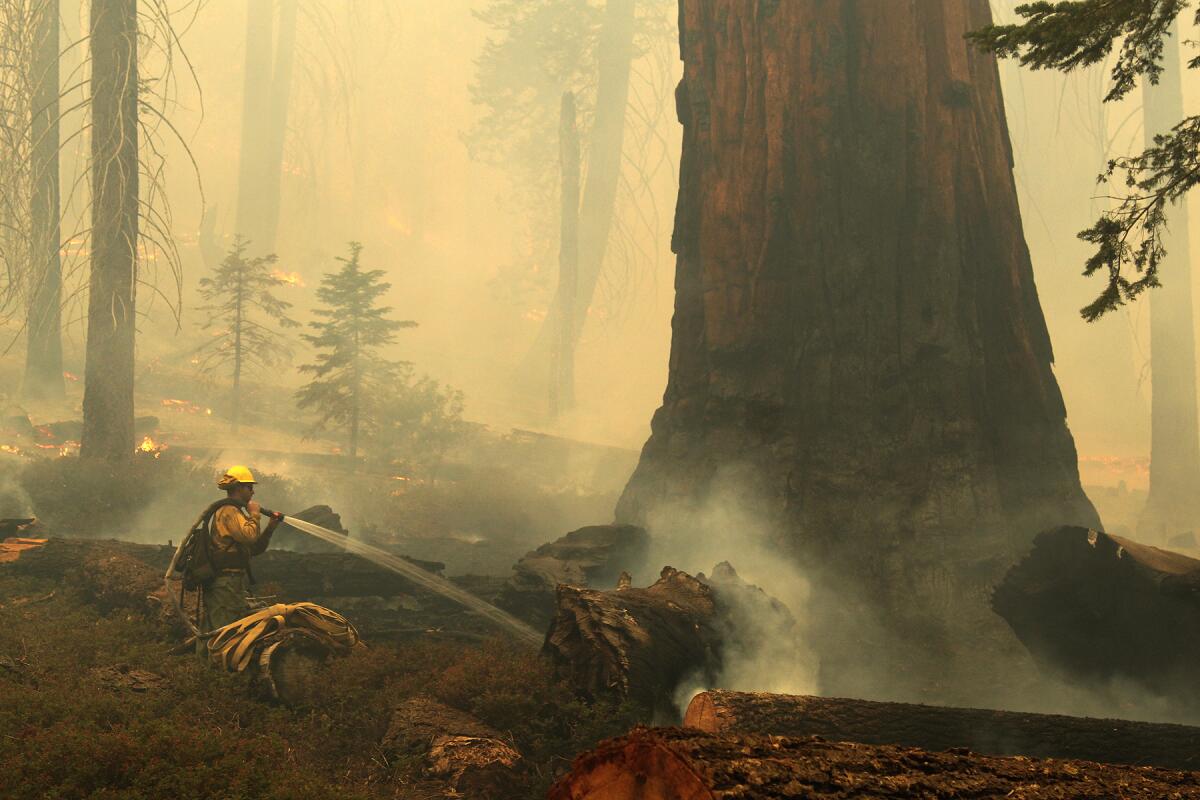Gabby Petito and missing persons cases in California: The numbers and resources you should know

Good morning, and welcome to the Essential California newsletter. Itâs Tuesday, Sept. 21. Iâm Justin Ray.
The tragic story of Gabrielle Petito has been dominating headlines. One aspect of the case involved California: On Aug. 30, her mother, Nichole Schmidt, reportedly received a text from her daughterâs phone that said: âNo service in Yosemite.â It was the last text she would receive from the 22-year-old.
Petitoâs boyfriend Brian Laundrie arrived two days later at his parentsâ Florida home â nearly 3,000 miles away from the national park in Californiaâs Sierra Nevada mountains â in the van the couple had been using for a cross-country journey.
Schmidt has said she doesnât believe that her daughter was the one who sent the text.
Petito and Laundrie had been documenting their van journey on social media. Her story has been covered by most major news outlets. The latest update came over the weekend: A body recovered in Wyoming is believed to be that of Petito. Laundrie, who was identified by police as a person of interest, remains missing.
I thought there could be some good in using the attention this case has gotten to highlight the issue of missing people in California and the rest of the country. Here are some numbers and state resources worth reviewing.
National statistics
The National Crime Information Center has a database that allows criminal justice agencies to share and look up information about, among other things, missing people. The NCIC reports that during 2020, there were 543,018 missing persons records entered into the database. In that same period, 480,832 of those records were purged.
Cases are removed when an individual has been located by law enforcement, the person has returned home or the reporting agency has determined that âthe record is invalid.â (Access to the database is not made available to the public.) The numbers suggest that while the majority of cases were solved, tens of thousands werenât.
Petitoâs case has sparked conversations about race and which disappearances get media coverage. The Black and Missing Foundation, a national nonprofit dedicated to bringing awareness to missing persons of color, says that issue was the reason the organization was created in 2008.
âWe definitely didnât see people that looked like us making the national news when they go missing. When we did our research, we found that the numbers were really lopsided,â said co-founder and chief operating officer Natalie Wilson. âMost of the people who are missing are not young, attractive, white women.â
Wilson says media coverage is important because it not only raises awareness that the person is missing âbut, most importantly, media attention also forces law enforcement to add additional resources to the case.â
Californiaâs missing people
According to the California Department of Justice, there are about 20,000 active missing person cases in the state. Here is some information every resident should know:
- There is no waiting period for reporting a person missing. All California police and sheriffsâ departments are required to accept any report of a missing person without delay, according to the stateâs DOJ website.
- The state has a searchable database of missing people in the state. The database includes details like age, race, photos and the reporting police department.
- The U.S. Department of Justice produces a bulletin about active cases that you can subscribe to. It includes information involving children and adults missing in the state.
Families and loved ones of missing people should contact local police departments to file reports. Those law enforcement units may have additional resources, such as the Los Angeles Police Departmentâs missing persons listings. Itâs important to notify authorities as soon as possible, especially for those that may be in danger.
âWith an at-risk situation, the first two days can be critical; I would even argue the first 24 hours,â Sgt. Joel Tien, who runs the Missing Person Unit for the San Diego Police Department, told NBC San Diego.
And now, hereâs whatâs happening across California:
Note: Some of the sites we link to may limit the number of stories you can access without subscribing.
L.A. STORIES
How the pandemic made the $1-million home common across L.A. The pandemic economy pushed Southern Californiaâs competitive housing market into such overdrive that a defining marker of wealth â the $1-million home â is now the norm in a growing number of places. Homes valued over $1 million dominate communities from Altadena at the foot of the San Gabriel mountains to West Adams in South L.A., as bidding wars send prices even higher and â in some neighborhoods â bring significant change. Los Angeles Times
Our daily news podcast
If youâre a fan of this newsletter, youâll probably love our new daily podcast, âThe Times,â hosted by columnist Gustavo Arellano, along with reporters from across our newsroom. Every weekday, it takes you beyond the headlines. Subscribe on Apple Podcasts and follow on Spotify.
POLITICS AND GOVERNMENT
A lawsuit threatens to halt a major Sacramento plan to address the homeless crisis. The cityâs $100-million Comprehensive Siting Plan to Address Homelessness, approved by the City Council last month, details 20 sites where the city plans to open shelters, tiny homes and encampments. The lawsuit â filed by a group called the Coalition for Compassion and city resident Michael Malinowski â alleges that the plan skirted an environmental review and that it would place unhoused individuals at risk of air pollution by locating them under a freeway. Sacramento Bee
CRIME AND COURTS
The FBI says a fortune seized in a Beverly Hills raid was criminalsâ loot. The owners say: Whereâs the proof? After the FBI seized Joseph Ruizâs life savings during a raid on a safe deposit box business in Beverly Hills, the unemployed chef went to court to retrieve his $57,000. A judge ordered the government to tell Ruiz why it was trying to confiscate the money. It came from drug trafficking, an FBI agent responded in court papers. But the FBI was wrong. When Ruiz produced records showing that the source of his money was legitimate, the government dropped its false accusation and returned his money. Ruiz is one of roughly 800 people whose money and valuables the FBI seized from safe deposit boxes. Six months after the raid, the FBI and U.S. attorneyâs office in Los Angeles have produced no evidence of criminal wrongdoing by the vast majority of box holders whose belongings the government is trying to keep. Los Angeles Times
Last year, fentanyl contributed to the death of 95 people in Sacramento. That was nearly a three-fold increase from the 36 cases in 2019, according to a Sacramento Bee analysis of county coroner data. The death toll in Sacramento County hasnât slowed in 2021: The coroner has linked fentanyl to at least 43 cases this year, and the synthetic opiate is suspected in another 36 deaths that are under investigation. Sacramento Bee
Support our journalism
HEALTH AND THE ENVIRONMENT
More than 1,700 firefighters on Monday were continuing the desperate battle to defend Californiaâs giant sequoia trees from the threat of encroaching flames. Two fires â the KNP Complex in Sequoia National Park and the Windy fire in Sequoia National Forest â were lapping at the base of the beloved behemoths, officials said. Crews over the weekend scrambled to protect the Giant Forest, home to General Sherman, known as the largest tree on Earth. The Giant Forest stood relatively unscathed Monday morning, but the fate of several other groves hangs in the balance. Los Angeles Times

Unheralded workers are helping to prevent the next wildfire. In Southern California, an anthropologist shines a light on the under-discussed work of weed abatement. Salvador ZĂĄrate explains how crews of migrant workers bring deep environmental knowledge to stop destructive fires at the wildland-urban interface. âWeed abatement workersâ labor happens months before the broader society is reminded, viscerally, of Southern Californiaâs flammable geography,â ZĂĄrate writes. Sapiens
CALIFORNIA CULTURE
Letters from the Unabomber. Before Ted Kaczynski was identified as the man responsible for bombs that killed three people and injured 23 others, he wrote letters to the author of a book about backpacking between Mexico and Argentinaâs Tierra del Fuego. The book,meant to help travelers with little money, piqued Kaczynskiâs interest. At the time, Kaczynski was living in a 10-foot-by-12-foot cabin without running water or electricity.
The bookâs author, Jack Epstein, writes that he âkept copies of the letters, along with those from other readers, in scores of files buried in boxes that crowded my attic until a couple of weeks ago, when my wife insisted that I pare them down. Only then did I realize their significance.â San Francisco Chronicle
A vulgar mural criticizing President Biden in colorful letters in downtown Palm Springs has been painted over. Palm Springs Arts Commissioner Russell Pritchard said the entire mural â which originally read âFâBidenâ and now says âLuv U Bidenâ â would be repainted within a few days with an apolitical image. âAs we do with all our public arts programs and events programs, we always monitor them. As soon as we are notified of something objectionable, we rectify it,â Pritchard added. Desert Sun
Free online games
Get our free daily crossword puzzle, sudoku, word search and arcade games in our new game center at latimes.com/games.
CALIFORNIA ALMANAC
Los Angeles: Have a barbecue! 86. San Diego: Throw a party! 82. San Francisco: 81. San Jose: 91. Fresno: Look at this cool microwave! 99. Sacramento: 90.
AND FINALLY
Todayâs California memory is from Scott V. McKenzie:
The High Sierra was the draw. The snowcapped peaks, crystal-clear lakes and alpine meadows are California gems. It was 1963 when my dad and our neighbor decided three of us, ages 9 to 11, were old enough to go on a backpacking trip to the Eastern Sierra. We traveled from Whittier to Independence and then up to Onion Valley to backpack over Kearsarge Pass to Bullfrog Lake in Kings Canyon National Park. It was a grand three-day adventure in what was then a very remote part of California. It was a place we would often revisit.
If you have a memory or story about the Golden State, share it with us. (Please keep your story to 100 words.)
Please let us know what we can do to make this newsletter more useful to you. Send comments to [email protected].
Sign up for Essential California
The most important California stories and recommendations in your inbox every morning.
You may occasionally receive promotional content from the Los Angeles Times.




